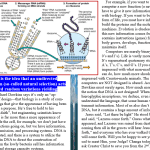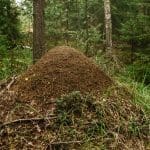[Originally published as These Algae Falsify an Evolutionary Prediction]
Two species that are closely related should compete for resources more strongly than two species that are distantly related.
This is a prediction Darwin himself made, and while it hasn’t been tested much, it has been assumed to be true ever since. In 1967, MacArthur and Levins formalized the prediction1, and, at least according to some biologists, it is “central to ecology and evolutionary biology.”2 It’s one of those ideas that makes sense in an evolutionary framework but is hard to test. As a result, most biologists have just assumed that it is true.
Well, while studying algae, Dr. Bradley J. Cardinale and his colleagues inadvertently put the idea to the test. They were trying to measure the competition that existed between 23 different species of green algae, such as the one pictured above (Coelastrum microporum). All these species are commonly found existing together in North American ecosystems, so it is assumed that they compete with one another. In their experiment, they took two different species from the group of 23 and put them together in a laboratory environment. They then measured how the two species competed with one another.
Now remember, they were looking at 23 different species, but they only put two species together to compete with one another. In order to look at all possible combinations of these 23 species taken two at a time, then, they had to examine 253 separate situations. They examined each combination of species twice, to make sure that their results were consistent, so they looked at a total of 506 competitive situations.
However, to compare how the species did in competition to how they did without competition, they also had to put each species in a laboratory environment on its own. They examined each of those situations twice as well.
In the end, they examined 552 different situations of algae growing in a laboratory environment. In other words, this was an extensive experiment. The results of this massive undertaking were rather surprising, at least to the investigators and many other evolutionists.
When they compared how strongly two species competed, they found that it was independent of how closely related they were. Here is how the investigators put it in their paper:3
Despite large variation in the nature of interspecific interactions, the average interaction strength did not vary as a function of the evolutionary relatedness separating interacting species.
So it seems that at least in the case of these common North American green algae species, the evolutionary prediction was falsified. The authors cite four other studies (including reference 2 in this post) that also seem to falsify the prediction.
While I would love to say that this “closes the book” on yet another failed evolutionary prediction, I have to point out that there are some studies that seem to verify the prediction. For example, a 2011 study showed that a group of microorganisms that like to eat bacteria compete with one another exactly how the prediction says they should.4 At minimum, however, I think it is safe to say that while the prediction might be valid in some situations, it is not applicable to the biological world as a whole. This, in itself, is a useful result.
Competition or Cooperation?
I would like to mention one other result from the algae study that the authors found “surprising.” They noted in their analysis that 23 percent of algae populations did better when put in “competition” with one another as compared to when they were allowed to live on their own.
I don’t find that surprising at all. As I look at the way God has designed the world, I find that cooperation is common among species (see here, here, here, and here, for example). It seems like many living organisms were made to live in a close relationship with other organisms from different species.
I wonder how much better our understanding of ecology would be if more ecologists started looking at ecosystems in this cooperative way.
References
- R. Macarthur and R. Levins, “The limiting similarity, convergence, and divergence of coexisting species,” The American Naturalist 101:377-385, 1967
- Cahill Jr., J.F., S.W. Kembel, E.G. Lamb, and P.A. Keddy. “Does phylogenetic relatedness influence the strength of competition among vascular plants?” Perspectives in Plant Ecology, Evolution, and Systematics 10:41-50, 2008
- Keith Jeffrey Fritschie, Bradley J. Cardinale, Markos A. Alexandrou, and Todd H. Oakley, “Evolutionary history and the strength of species interactions: testing the phylogenetic limiting similarity hypothesis,” Ecology http://dx.doi.org/10.1890/13-0986.1, 2014
- DR, Pu Z, Jiang L., “Phylogenetic limiting similarity and competitive exclusion,” Ecology Letters 14(8):782-7, 2011






